
Methane has been the Achille’s heel for cattle emissions, but it may be part of a climate solution
Highlights:
-
GWP* is a new way to help measure the true warming impact of short-lived climate pollutants, such as methane.
-
Methane from cattle is not only emitted, it is also destroyed relatively quickly. This means it’s warming impact should be measured differently than that of CO2.
-
Methane is a potent greenhouse gas, and rising emissions would be really bad for the climate, but by reducing methane from livestock – such as through manure management or feed additives – cattle can help be part of a climate solution.
Massive tent-like structures at the University of California, Davis, overlook pens of Black Angus cattle. The Bovine Bubbles, as they’re called, are impressive, and could be mistaken as hangars for the airport next door. Instead, they house cattle, and feature an intricate system of fans and tubes running from structure to structure while measuring cattle emissions.
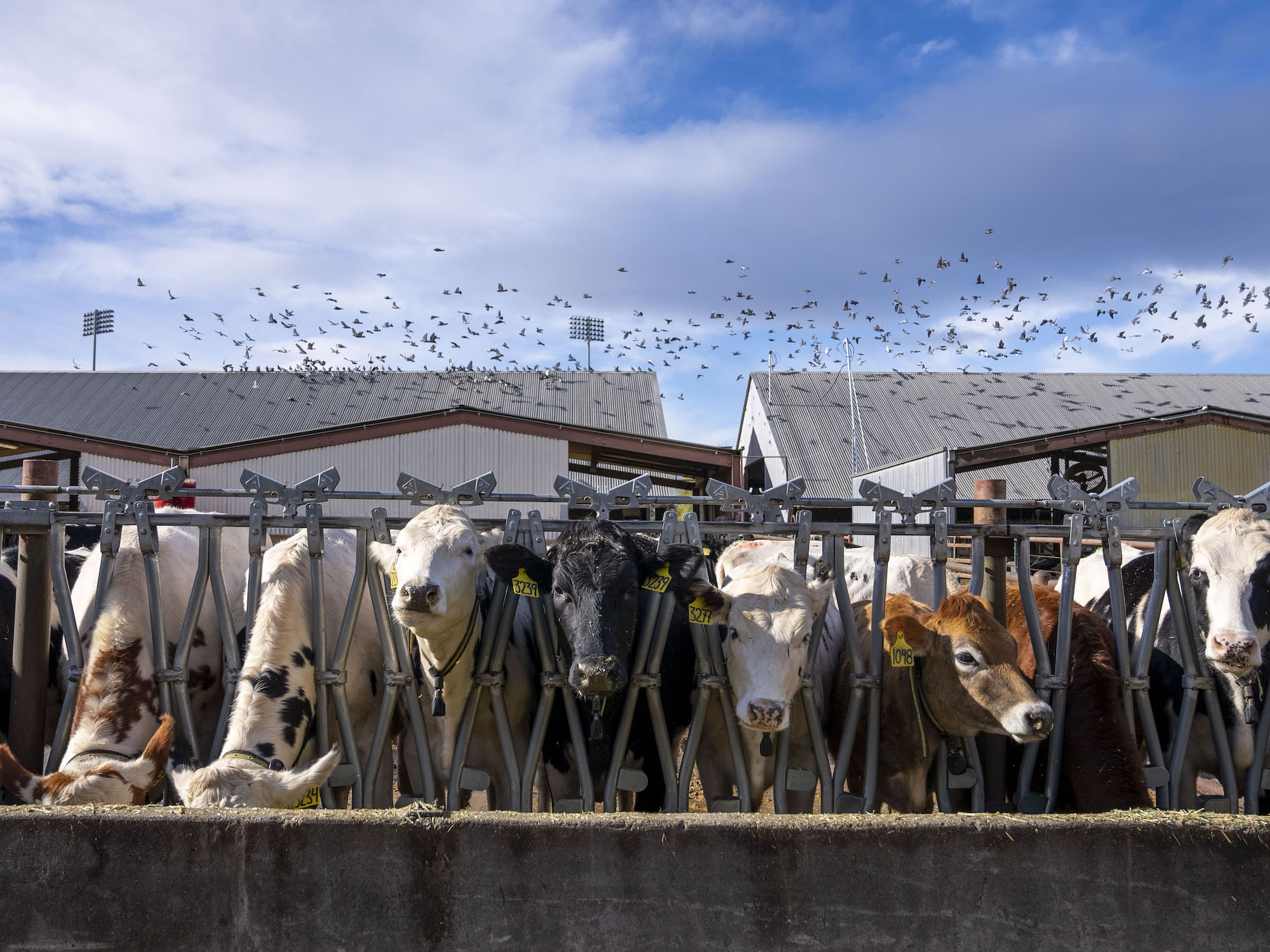
GWP* More Useful in Measuring Warming Cause by Livestock Methane Emissions
New study uses case studies from the California Dairy sector to show GWP* is a better tool for quantifying methane in emissions inventories.
The lab is the brainchild of Frank Mitloehner, a UC Davis professor who studies animal agriculture and its relationship to air quality and the climate. Based on his research and work with farmers worldwide, Mitloehner is of the mind that food sourced from livestock is necessary to sustain a world population expected to reach 10 billion by 2050. Even more, he maintains we can get to a place where we can produce enough food without furthering climate change.
That’s a startling assertion, given livestock’s – most notably cattle’s – reputation for being nefarious, a climate pollutant source we should avoid. But according to Mitloehner, it’s an urban legend rooted in falsehoods and a misunderstanding of where animals’ methane comes from and how it behaves in the atmosphere. He’d like to set the record straight.
Monitoring cattle’s diets
With that goal in mind, Mitloehner and his team closely monitor cattle on varying diets. Some get standard industry fare, while others are given feed that’s designed to reduce methane from the enteric fermentation that takes place in cattle’s stomachs or, rumens.
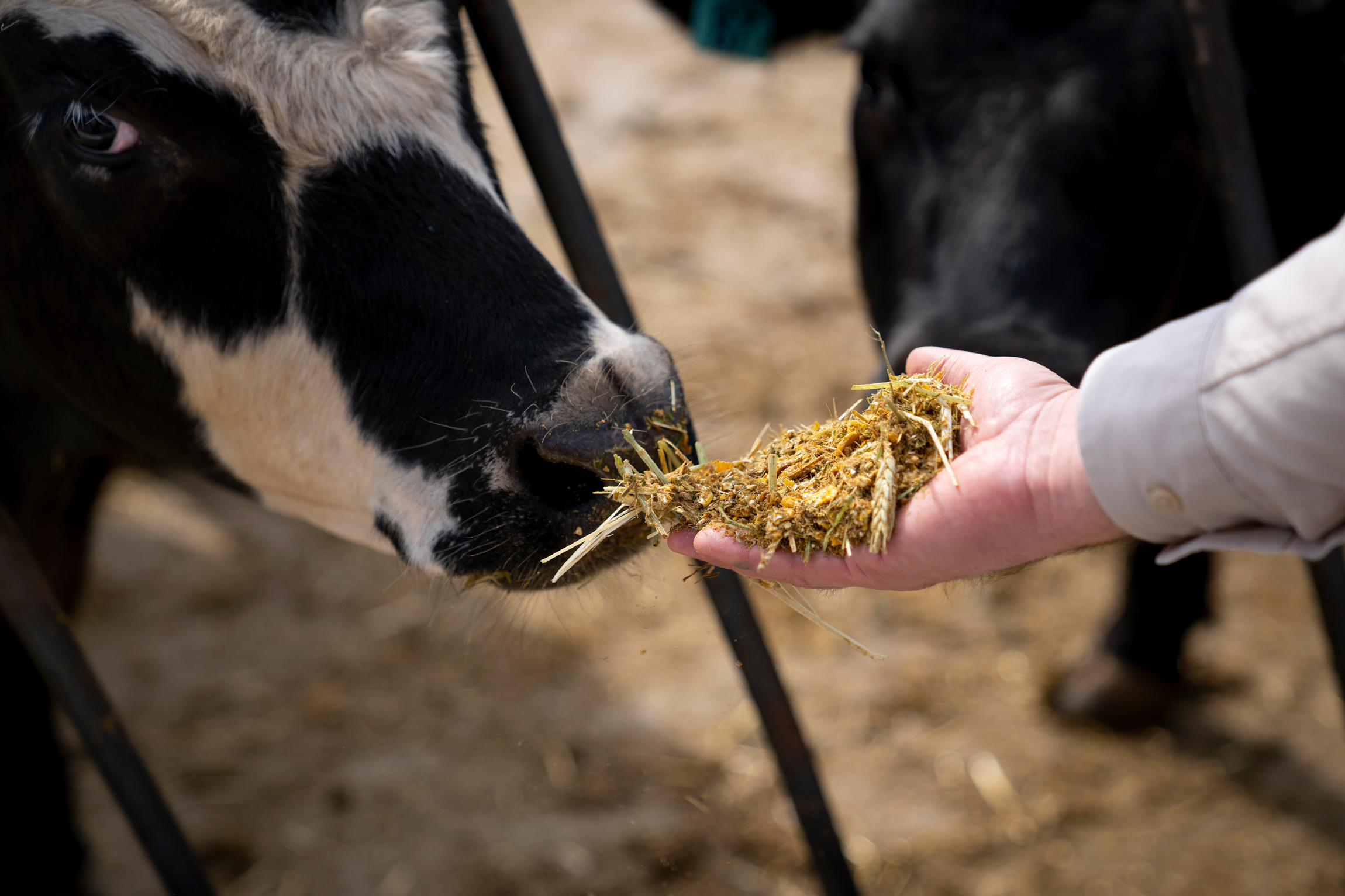
Emissions from their belches and manure are then measured in a separate building – a mobile air quality monitoring lab, full of gauges and other bells and whistles that sits in contrast to the 100-year-old barn just outside the door. Every burp and resulting emission a bovine makes is documented here in painstaking detail. It’s important for a number of reasons, not the least of which is providing clarity about how cattle’s methane emissions affect climate change.
“There’s nothing like this anywhere else in the world,” Mitloehner says. “It’s the only facility in the U.S. for large group housed cattle studies under near commercial conditions. We conduct so-called “label claim studies” to reduce air emissions under the auspice of the FDA (U.S. Food and Drug Administration).”
Understanding biogenic methane
The endeavor is far more than a rigorous academic pursuit. Mitloehner knows methane from livestock is unique among the family of greenhouse gases. A different animal, as it were. In addition, he believes fully understanding its distinct characteristics is key to making animal agriculture climate neutral and even a player in the solution to warming.
“There are really only two sectors of society that can extract greenhouse gases from the atmosphere, and they’re agriculture and forestry,” Mitloehner says. “But what's really intriguing is that within agriculture, the livestock that emits methane has a really high impact. So, if you reduce methane, you can induce a strong cooling effect.”
If his claim sounds revolutionary, it’s because the life cycle of biogenic methane – the type that comes from cattle, sheep and other ruminants – is rarely discussed outside of scientific circles. As a matter of fact, methane is created from atmospheric carbon dioxide that’s used by plants that become food for animals that emit methane during digestion. Once that happens, methane hangs in the atmosphere for about 12 years, strongly affecting our climate during that time. But then it’s broken down into carbon dioxide, and returned to the atmosphere where the cycle can begin anew.
In a nutshell, that’s what Mitloehner’s work addresses. It’s a story that’s not often told in mainstream media, and that’s most likely due to the fact that misconceptions about animal agriculture’s part in warming have obscured scientific facts, clouding solutions to climate change and food security worldwide.
The greenhouse effect and climate change
Methane is one of a number of gases responsible for collecting above Earth and creating what is known as the greenhouse effect. Since the beginning of time, carbon dioxide (CO2), nitrous oxide (N2O), methane (CH4) and a few extraneous gases have created a ceiling of sorts that traps heat from the sun and blankets our planet with it. It’s not a bad thing. In fact, were it not for the greenhouse effect, Earth would be too cold to sustain life.
However, in the last 100 years or so, we have produced a record amount of greenhouse gas emissions. These gases are behaving as they were meant to; trapping heat from the sun. Because there is an unprecedented amount, they’re causing the planet to overheat. That’s what was referred to as global warming, and the phenomenon that is driving climate change.
Yet, within that scenario, not all greenhouse gases are created equally. According to Mitloehner, if we look at them individually, we find they don’t all behave or warm in the same way, even though we’ve been quantifying them as if they do.
Get to know methane from animals

It’s no secret that cattle and other ruminant animals produce methane. What’s lesser known is that they are hardly its lone source. The gas is emitted during the extraction and production of fossil fuels, which may be a larger source than we imagined, and when organic waste decomposes in landfills. It’s given off by wetlands as well as by the animals mentioned above.
Chemically speaking, methane is methane is methane. It is always a compound made up of one carbon atom bonded to four hydrogen atoms. That said, the source of methane is significant; where it comes from makes a difference in how it affects our atmosphere, the greenhouse effect and climate change.
Generally speaking, there are two paths for methane:
- A one-way route to the atmosphere. This is the course for fossil methane, the gas that comes from fossil fuels from the Earth’s crust. It’s a brand-new addition to the atmosphere, and once there, it hangs above us for about 12 years before being converted to carbon dioxide and water vapor. After it becomes CO2, it stays in the atmosphere for more time than we can count, simply because of the glut already there. This results in additional, new carbon in the atmosphere and new warming.
- The biogenic cycle. Biogenic methane from animals is a short-lived (i.e., 12-year) climate pollutant and a flow gas made from atmospheric carbon that has been cycling through the atmosphere since life began. As part of the biogenic carbon cycle, plants absorb carbon dioxide, and through the process of photosynthesis, they harness the energy of the sun to produce carbohydrates such as cellulose. Indigestible by humans, cellulose is a key feed ingredient for cattle and other ruminant animals. They are able to break it down in their rumens, taking the carbon that makes up the cellulose they consume and emitting a portion as methane, which is CH4 (note the carbon molecule). After about 12 years, the methane is converted back into carbon dioxide through hydroxyl oxidation – a chemical reaction in the atmosphere. That carbon is the same carbon that was in the air prior to being consumed by an animal. It is recycled carbon. As long as herd emissions remain constant for more than 12 years, no additional methane – or warming – is being added to the atmosphere in the biogenic carbon cycle.
“What makes methane from animal agriculture a flow gas is that it's not just produced, it's destroyed and taken out of the atmosphere,” Mitloehner explains. “Methane has a half-life of around one decade, after which it's converted back into CO2, from which it originated.” In other words, a true short-time carbon cycle from one form to another and back.
That’s very different from a stock gas such as the CO2 that comes from the tailpipe of your car. “Anytime you emit it, it’s added to the existing stock in the atmosphere,” Mitloehner says. “Flow gas replaces existing gas with gas that results from the former gas. And so that's a totally different concept compared to a stock gas that only adds to existing stocks.”
While still a flow gas, fossil methane will eventually be oxidized into CO2 and added to the atmospheric stock as new and additional warming. Carbon dioxide is an long-lived climate pollutant (LLCP), a stock gas that keeps building up in the atmosphere and increasing the existing stock – hence the designation. By conservative estimates, carbon dioxide hangs over us for 1,000 years. Potentially, forever. That’s because the carbon sinks, oceans, soils and plants that remove it are simply overwhelmed. Blame humans, not cattle, for that. Our love affair with the burning of fossil fuels is not cooling down. Consequently, neither is the atmosphere.
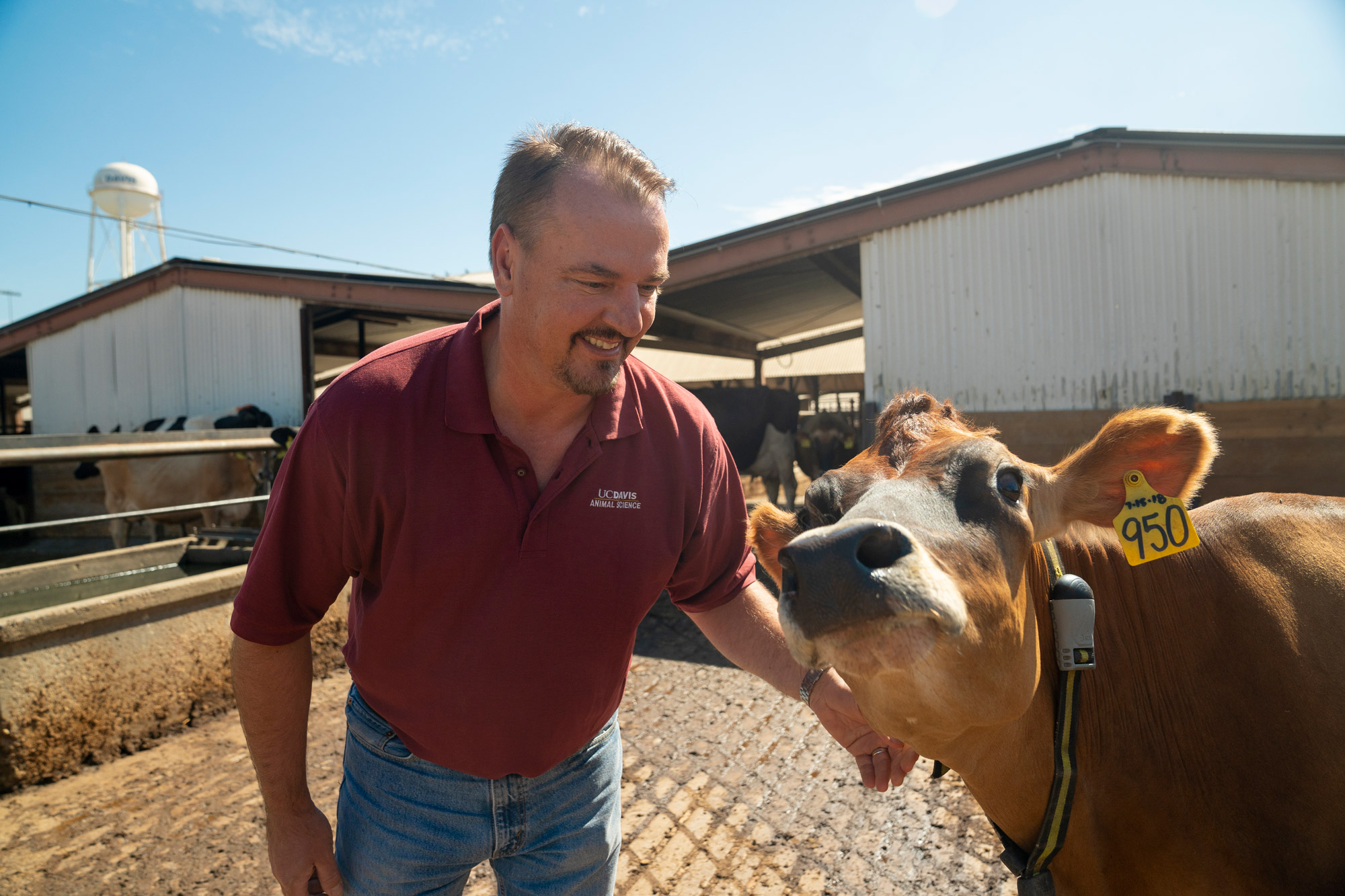
Methane’s potency versus its actual warming effect
Even the most casual observer of greenhouse gases likely has heard that methane is a potent compound. That’s absolutely true, and we must take methane emissions seriously, though it’s potency is only one part of consideration when it comes to how it warms.
In 1990, scientists established a system known as GWP100, which was meant to level set the global warming potential (GWP) of carbon dioxide, nitrous oxide and methane. According to GWP 100, carbon dioxide has a score of 1; methane, 28; and nitrous oxide, 265. In other words, 1 kilo of methane is 28 times more potent than 1 kilo of carbon dioxide over a 100-year period.
But wait. The flow gas methane doesn’t last for a century, and the stock gas carbon dioxide is around for one thousand years, if not forever, making the 100-year comparison rather forced, akin to trying to fit a square peg into a round hole.
“What makes methane from animal agriculture a flow gas is that it's not just produced, it's destroyed and taken out of the atmosphere,” Mitloehner says.
The creators of GWP100 had good intentions. They wanted to standardize the impact of each greenhouse gas in order to allow us to draw comparisons and get our arms around this behemoth called global warming. GWP100 is an easily digestible convention that’s well-known and even used to drive policy and regulations aimed at limiting warming. But the system simply measures methane’s carbon dioxide equivalence (CO2e) and overlooks how methane warms the atmosphere. That’s a big miss, Mitloehner says.
Consider carbon dioxide from fossil fuel production and biogenic methane from a cow emitted at the same time. The carbon dioxide joins the existing stock and begins warming the planet almost into perpetuity. Over the first decade of its existence, methane will warm the atmosphere 28 times more than carbon dioxide. Then the warming from biogenic methane is neutralized, because it undergoes hydroxyl oxidation, which converts it back into carbon dioxide and water vapor. Though methane is transformed into another greenhouse gas, it’s important to note that the resulting carbon dioxide is returned to the atmosphere, and is not new, additional carbon dioxide. It’s recycled. If it’s fossil methane, such as from shale gas extraction, the resulting carbon dioxide from oxidation will go on to warm for centuries, as the carbon dioxide is added to the stockpile we already have.
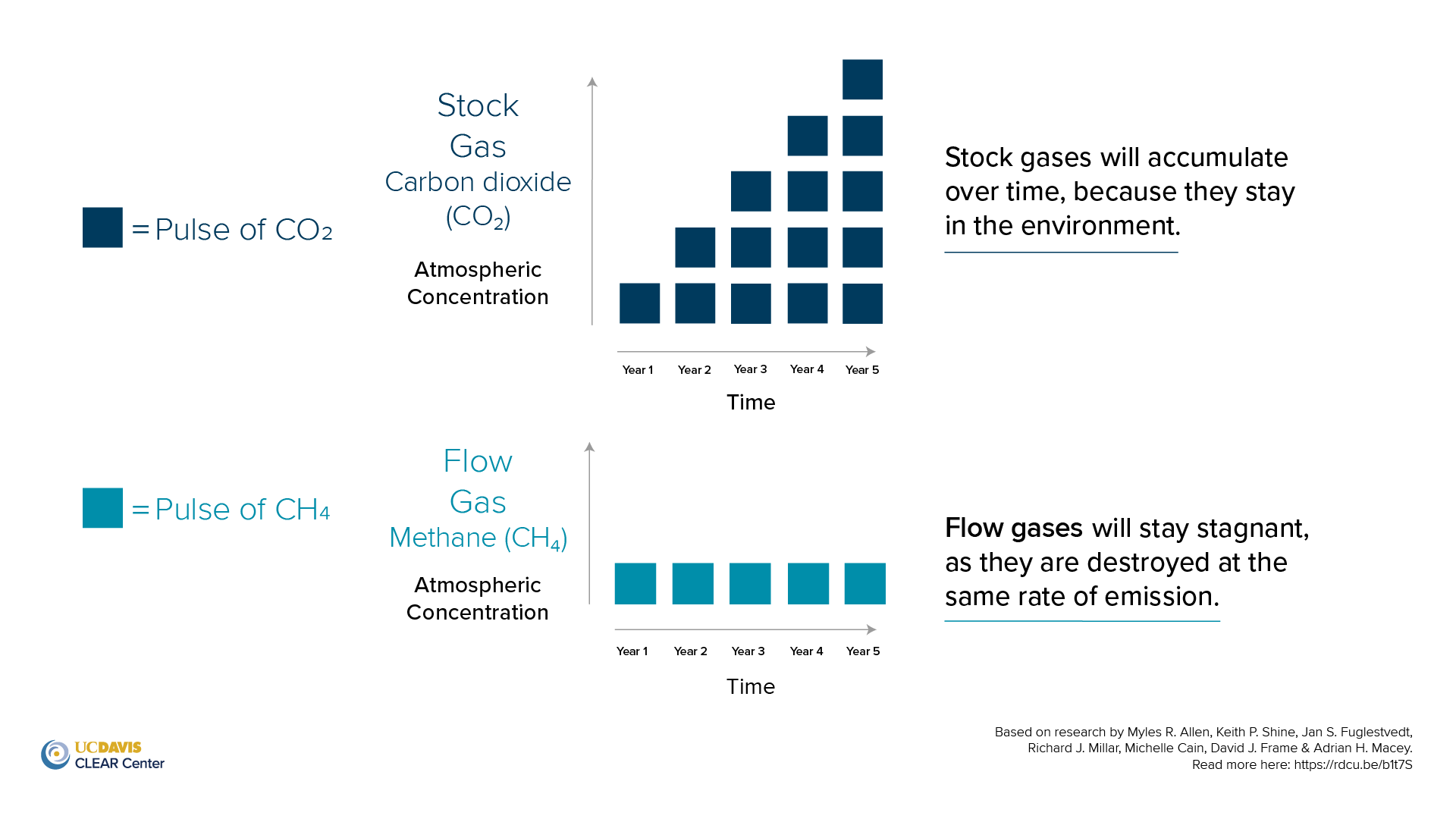
Methane’s short lifespan is also relevant in regard to warming. As a flow gas, it is being destroyed at a similar rate of being emitted. Methane’s actual warming impact is determined by how much more or less methane is being emitted over a period of time. This is referred to as the rate of change of emissions.
What’s notable about methane is that if a herd of cattle emits the same amount of methane over 12 years, it is contributing to warming for those first 12 years. But afterward, the amount being emitted is equal to what is being destroyed through oxidation. Consequently, warming is neutral, providing the methane emissions stay constant.
“If we increase methane emissions, warming will increase – and we certainly need to prevent that.” Mitloehner said. “But a really intriguing aspect of biogenic methane, is that if we are able to reduce it, as we have done with smaller, more efficient herds and dairy digesters, then good things can happen.”
Methane can be part of a climate solution
There’s no denying the extraordinary amount of carbon dioxide in the atmosphere, and if we’re going to limit warming, we need to reduce our dependency on fossil fuels. As organizations and individuals debate on what to do, one of the solutions might be right before our eyes – or more literally, in giant bubbles on the UC Davis campus.

Methane, Cows, and Climate Change: California Dairy's Path to Climate Neutrality
UC Davis White Paper Re-Examines Methane’s Role in Climate Change, and How California Dairy Can Achieve Climate Neutrality
Though methane is frequently presented as a fearsome greenhouse gas, especially when it’s emitted by cattle, research suggests we need to begin looking to it for its potential to have a cooling effect.
Meat consumption is rising across the globe, particularly in developing countries as they acquire more wealth, meaning that animal agriculture will likely continue to be part of a global diet. According to Mitloehner and others, it’s likely here to stay and necessary. Eliminating all cattle isn’t a realistic solution, so researchers in Mitloehner’s lab are working to reduce livestock’s methane emissions and impact on the environment. According to Mitloehner, the answers can be found in the world’s farmers modeling the efficiency advances American farmers have been making for decades. That is, increasing outputs while holding inputs steady. In addition, research into feed that will make cattle less gassy is proving itself promising.
Keeping animal agriculture’s methane emissions constant over time puts animal agriculture on the path to climate neutrality. Furthermore – and this is key – if the sector can reduce the level of methane emissions today by more than 10 percent, they will be contributing to negative warming. The reason is simple. Less methane means the natural carbon cycle is actively pulling from the stockpile of carbon dioxide in the atmosphere. Hence, the sector can help pull carbon from our atmosphere.
A new way of measuring GHGs’ warming
To better calculate methane’s climate impact, scientists from Oxford are suggesting a revised version of GWP100 to measure short-lived greenhouse gases; a metric called simply “GWP*". Instead of measuring one methane pulse emission against a same-size pulse emission of carbon dioxide, world-leading climate scientists, Myles Allen, Michelle Cain, John Lynch, Dave Frame and other teams of researchers, are suggesting a more reliable approach that takes into consideration the differences in how short-lived climate pollutants and long-lived climate pollutants actually warm the atmosphere.
That is, the scientists advocate measuring the change over time in the emission rate – which is, how much more or less is being emitted over time – instead of comparing a pulse of methane with a single pulse emission of carbon dioxide. Under the guidelines of the GWP* standard, one could more accurately understand the actual warming effect of adding a cow to one’s herd (and thus, an increase in methane), or the climate effect of using feed additives to reduce enteric fermentation, for example.
Their conclusions are stunning. Using GWP*, the following set of graphs shows what happens when carbon dioxide and methane emissions, respectively: 1) rise; 2) remain constant; and 3) decrease.

Source: https://www.nature.com/articles/s41612-019-0086-4
The left panel shows how increasing emissions of carbon dioxide versus methane both increase warming. In the case of carbon dioxide, it occurs at a much faster rate, simply because we’re creating an ever-larger stockpile of it over time. Today’s emissions of carbon dioxide are being added to yesterday’s emissions and those of the day before, and the day before, and the day before, ad infinitum. In other words, the stock gas CO2 is accumulating leading to exponential increase in warming. It’s a different story for methane. When methane increases, warming follows in a linear fashion. Though warming increases when additional methane is emitted, it does so at the rate of emission, because the methane of yesteryear is long gone, having been recycled. Warming is coming from the new, incremental methane in the air.
The center panel shows a scenario where emissions of both gases remain constant, but only carbon dioxide leads to increasing warming, while warming via methane is neutral. This is because methane is being destroyed at the same rate that it’s being emitted. Thus, there is no additional warming.
On the other hand, carbon dioxide’s warming continues to increase, because it’s being added to the atmosphere without the earlier carbon dioxide being sequestered or destroyed. Again, that CO2 is being added to atmospheric concentration of CO2.
Finally, in the right panel, emissions of both gases are reduced to zero. Carbon dioxide’s warming continues to rise, since even though a decreasing amount is being added, whatever is released into the atmosphere will join the atmospheric stock and further warm. It eventually levels off, but without removing CO2, that’s the best we can hope for. Methane, on the other hand, immediately reduces warming. This is why you hear so much about methane being an immediate tool in slowing down global warming. That’s owed to the fact that methane is a flow gas and as it is emitted, it is also being destroyed. So, less methane in the atmosphere means more is being destroyed than is being emitted. In this methane reducing scenario, carbon is actively taken out of the atmosphere leading to negative warming, or better said “cooling”.
Furthermore, plants continue to need carbon dioxide, and they will naturally draw from the surplus of carbon dioxide from other activities if methane isn’t providing enough. While we grapple with how to reduce our national and even global footprint, methane can help keep global warming at bay, providing we succeed in reducing it.
GWP* and methane from cattle
Mitloehner is hopeful that we can, at least where livestock is concerned, reduce its warming impact and even turn it into cooling. GWP* can better inform our progress and help us get there.
Since 2015, California dairies have reduced manure methane emissions by 2.2 million metric tons of CO2 equivalence, which is about 30% of their 7.2MMTCO2e goal. It's likely the dairy sector is further along in its goal as those results are with about half of the digesters that are actually in use in California. Technologies such as digesters are positioning the state more than halfway to meeting its 2030 goal of reducing methane by 40 percent. Dairy farmers also have reduced their carbon dioxide emissions by incorporating solar energy, LED lighting and electrification of feed-mixing and water-pumping operations. It’s an accomplishment that benefited from farmers, regulators and researchers working together to solve a problem. Because of that, California dairies are on the path to climate neutrality. We need more of that as we move forward, Mitloehner believes.
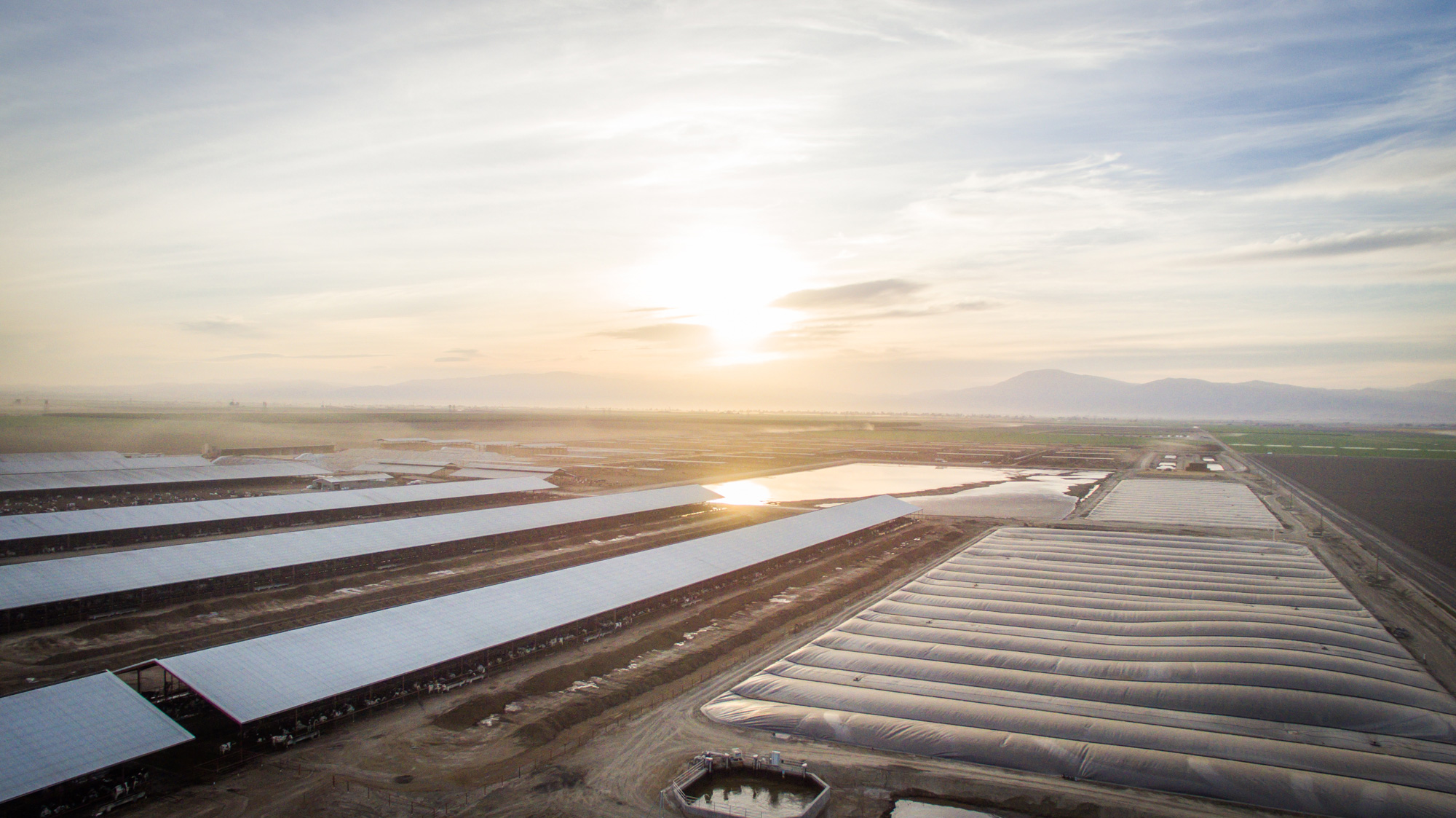
“The state incentivized the use of anaerobic digesters, which are pretty much a cap over the lagoon where the manure is stored,” he says. “The biogas that's then being trapped is converted into fuels such as renewable natural gas, RNG. And that RNG is then used to fuel vehicle fleets, such as semi-trucks. So that's a double whammy because you're reducing emissions from a lagoon with the manure stored on the one hand and you convert the resulting gases into fuel that then reduce diesel emissions and replace that with a much cleaner emission of gas.”
Still, atmospheric concentration of methane has increased since the early 2000s, largely due to fossil fuel production, according to new research. It goes without saying that we need to find and embrace renewable energy sources and reduce waste.
A caveat in regard to methane and the climate
While methane mitigation could alleviate the problem of warming and actually lead to cooling effects, it would provide merely short-lived relief if we don’t decrease carbon dioxide emissions. Because carbon dioxide is a stock gas, continuing to accumulate and further warm the atmosphere, the stockpiling of carbon dioxide will eventually overcome the benefit brought about by a reduction in methane. We need to aggressively reduce our carbon dioxide emissions by focusing on our reliance on fossil fuels, the biggest contributor by far to global warming. Other initiatives – such as planting trees – simply fall short by orders of magnitude of getting us to where we need to be.
Nevertheless, reducing methane is a significant short-term opportunity that we should pursue, as it buys time to further reduce CO2 emissions.
Don’t take it personally
We all need to be conscious of and respectful to each other and to our planet. Still, if we ever hope to change the warming trajectory, Mitloehner maintains we need to understand the facts and come together to find real and lasting solutions.
Not only is eating meat and dairy products not a major driver of the problem. It might well be part of the solution.
“What gets me the most excited is that if we reduce methane from, let's say, cattle, then we are actively pulling carbon out of the atmosphere. That's almost as if you were to store atmospheric CO2 in the ground,” Mitloehner says. “Can it be done? It can be done, and it has been done.”
